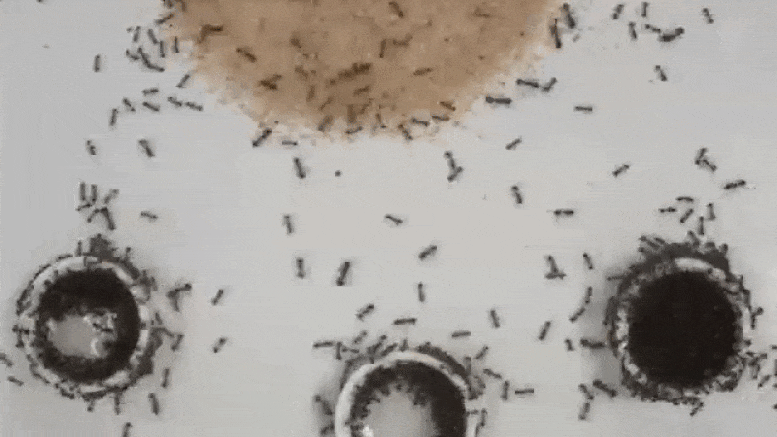Researchers have observed that black imported fire ants use sand to pull liquid food out of containers when they are at risk of drowning. This is the first time that such sophisticated tool use has been reported in these animals. These results are published in the British Ecological Society’s journal Functional Ecology. Photo credit: Dr. Aiming Zhou and Dr. Jian Chen
Researchers have observed that black imported fire ants use sand to pull liquid food out of containers when there is a risk of drowning. This is the first time that such sophisticated tool use has been reported in these animals.
A study published in Functional ecology demonstrated for the first time that a species of ant has the remarkable ability to adapt its tool use. When black imported fire ants were provided with small containers of sugar water, they could swim and feed on the surface. However, when the researchers reduced the surface tension, the ants began to deposit grains of sand on the inside of the container leading out of it.
“We found that the ants used sand to build a structure that could effectively pull sugar water from the container and then collect it,” said Dr. Aiming Zhou, Associate Professor at Huazhong Agricultural University in Wuhan, China and lead author of the research.
“This extraordinary ability to make tools not only reduced the risk of ants drowning, but also gave them more space to collect sugar water.”
The sand structures were found to be so efficient that they could suck almost half of the sugar water from the containers in five minutes.
The researchers changed the surface tension of the sugar water by adding surfactant. When the surfactant concentrations were above 0.05%, which posed a significant risk of drowning, ants were observed building up the sand structures to suck up sugar water from the container. These structures were never observed when ants were eaten in containers of pure sugar water, suggesting an adaptive approach to this novel tool use.
The results show not only the ability of black imported fire ants to use tools for foraging, but also that they can recognize an increased risk of foraging and adjust their tool use in response.
Researchers have observed that black imported fire ants use sand to pull liquid food out of containers when they are at risk of drowning. This is the first time that such sophisticated tool use has been reported in these animals. Photo credit: Dr. Aiming Zhou and Dr. Jian Chen
Dr. Jian Chen, research entomologist with the US Department of Agriculture (USDA) Agricultural Research Service (USDA) in Stoneville, Mississippi, and another research author, said, “We knew that some species of ants could use tools, especially when collecting liquid food; However, we were surprised at this remarkable tool use shown by black imported fire ants. Our results suggest that ants and other social insects can have considerable cognitive skills for unique foraging strategies. ”
The use of tools is seen as an indicator of cognitive sophistication and has been mainly observed in primates and some bird species. In invertebrates, however, this behavior has been less well studied and has previously been viewed as hard-wired and inflexible.
Black imported fire ants, Solenopsis richteri, are native to South America, but are invasive to the southern United States when introduced. Their hydrophobic exoskeletons allow them to swim on water, but it is likely that they are still at frequent risk of drowning in nature due to the importance of liquid foods like nectar and honeydew as a source of carbohydrates.
In the study, the researchers calculated the risk of drowning by measuring the proportion of drowned ants in 2.5 cm containers of sugar water with different surfactant concentrations. The ants could swim on the surface of pure sugar water, but the proportion of ants drowned increased significantly with increasing concentrations of surfactant. The researchers then provided ants with sand of different grain sizes to test their preferences in creating sand structures when they were exposed to different risks of drowning.
Dr. Zhou warns that further study is needed in this research area, saying, “Our experiments are being conducted in the laboratory and are limited to only the black imported fire ants.” The next steps will be to see how widespread this behavior is in others Ant species is. Dr. Chen adds, “Our study is the first to address this interesting topic. We hope that our paper will motivate others to conduct the appropriate research. ”
Reference: “Ants adapt their tool use strategy to the risk of foraging” by Aiming Zhou, Yuzhe Du and Jian Chen, October 7, 2020, Functional ecology.
DOI: 10.1111 / 1365-2435.13671



